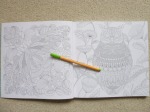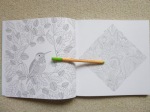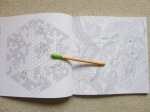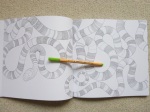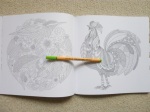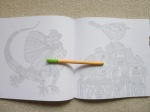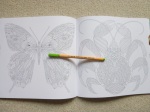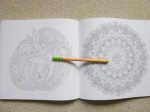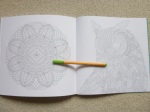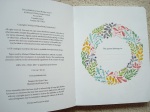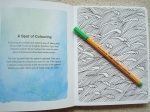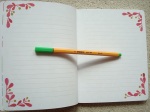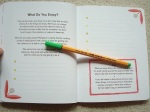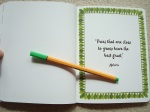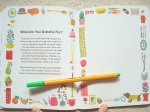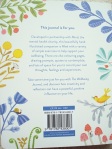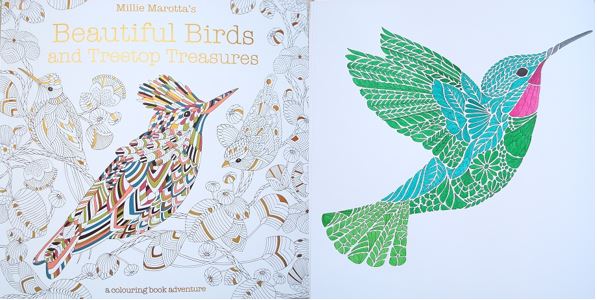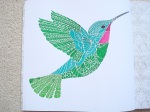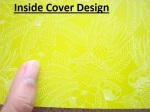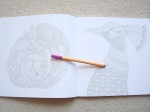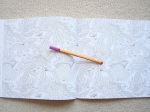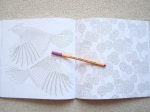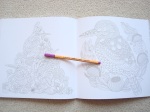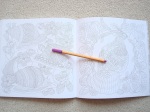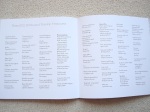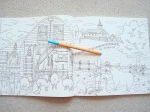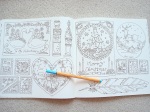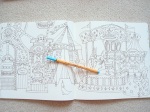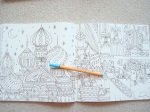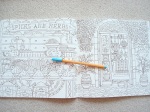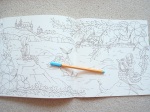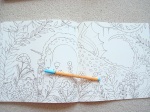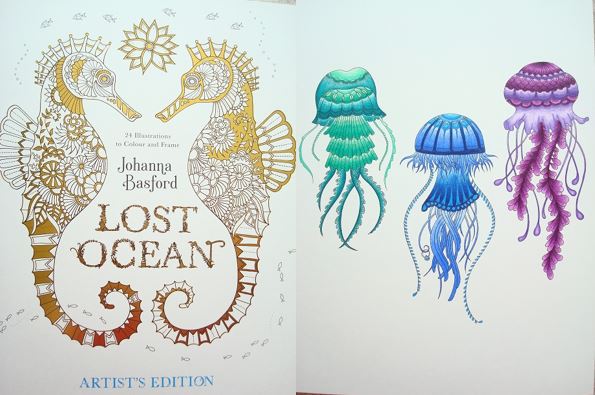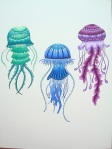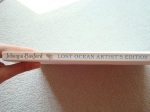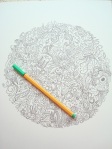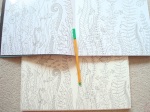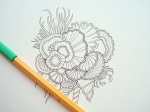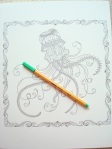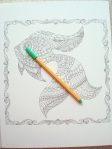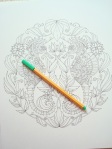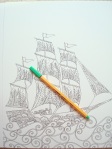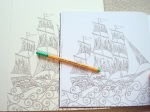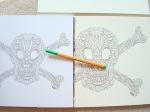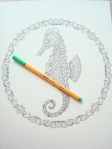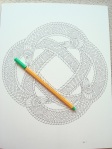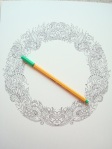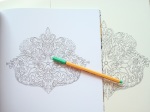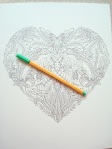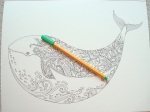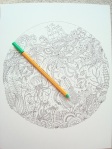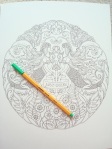Disclaimer – Please read this disclosure about my use of affiliate links which are contained within this post.
Millie Marotta’s Wildlife Wonders is published by Batsford Books who very kindly sent me a review copy. This is the sixth book in Millie’s animal-centred adult colouring book series and this time it contains no new images and instead it’s a compilation of Millie and the colouring community’s favourite images from her first five books. It’s the same size and shape (25cm square) as her previous books, paperback, with flexible card covers with black and white line drawings that hint at some of the wonderful creatures within the pages and a few of the illustrations are coloured with gold foiling scattered across the cover and the title. The spine is a lilac colour which compliments the other spine colours really well and they look gorgeous on the shelf together (see photo below). The covers don’t have French flaps this time but the inside covers are a lovely teal colour with white line drawings of animals all over them (this isn’t colourable and is printed on quite glossy card). The spine is glue and string-bound so it’s very durable but it does mean that a little of some of the images is lost into it until it eases up with a bit of use. The images are a mixture of single and double-page spreads, none of them are mirror images this time. The paper is bright white and lightly textured, it’s the same paper as the previous titles and doesn’t bleed but does shadow a little with water-based pens; pencils work beautifully and blend and shade really well.
The book starts with a two-page introduction from Millie herself where she explains her illustration choices. Following this are a whopping 120 pages of the best illustrations from each of her 5 previous titles. This book really does contain absolutely everything from the common to the most exotic, animals you’ll easily recognise and those you’ll never have seen before, there is a mixture of all sorts! Everything is included from pheasants to an octopus, snakes to butterflies, chameleons to bats, jellyfish to parrots, elephants to mushrooms, seahorses to peacocks, crabs, bees, frogs, moths, snails, owls, and even an axolotl. This time there are no plain images; in the previous books there were a few pairs of images where there would be a detailed version and a simpler one that you could add your own details to if you wish, some of the detailed versions are included but no simpler ones this time. There also isn’t a list at the back of the book detailing the creatures of each page so you will have to guess a bit I’m afraid. Some people have criticised Millie’s previous books as being bird-heavy, this book really doesn’t feel that way with 40 of the images depicting birds and the other two thirds showing all manner of other creatures. The images are really varied but definitely feel more heavily detailed than some of her earlier books and with fewer scenery pages. As always, I’ve gone a bit extreme with this review and spent hours trawling through this book and all of the others to discover how many pages from each book are included and the totals are as follows: Animal Kingdom – 24; Tropical Wonderland/World – 27; Wild Savannah – 21; Curious Creatures – 24; Beautiful Birds and Treetop Treasures – 24.
In terms of mental health, yet again, this book is fantastic. There is so much to look at, so much to discover, that it’s incredibly distracting and really focuses your mind on the illustrations themselves rather than any difficult thoughts or feelings you may be having. The image content is totally absorbing and nature-based images are the best for relieving symptoms of mental illness. This book is very intricate, but don’t let that scare you, you can use pencils, fine-nibbed felt tips, fineliners and gel pens, all with great effects and most of the images aren’t so detailed that you’re put off or overwhelmed. Many of the patterns drawn onto the animals can be coloured over in blocks as well making them less intricate and giving your colouring texture and pattern rather than outlined spaces to colour, so the possibilities are endless. If you have vision problems or issues with fine motor control then you may struggle with this book but for any of the rest of you I’d suggest giving this book a go and persevering into a more intricate world. The natural scenes definitely create a sense of calm and this will be one of my go-to books when I really need to focus on something and be distracted. It’s detailed enough that you have to focus and concentrate and this lends itself wonderfully to drowning out any anxious or disturbing thoughts you may want to shift. The line thickness is consistent throughout and is very thin so I’d advise colouring during the day or near a very good desk lamp. The images are wonderful, as always and it’s great to have a second opportunity to colour your favourites in a different colour scheme
I can’t praise this book highly enough, I love Millie’s work and this book is a stunning compilation of the best images from her previous books. The illustrations lend themselves to whatever colour scheme you fancy whether that be realistic, rainbow, monochrome, black and white, mixed media, or anything else you can dream up, it really is beautiful and it would make a perfect first book if you can’t or don’t want to pick a themed one.
If you’d like to purchase a copy it’s available to pre-order here:
Amazon UK – Millie Marotta’s Wildlife Wonders
Book Depository Worldwide – https://www.bookdepository.com/Millie-Marottas-Wildlife-Wonders-Millie-Marotta/9781849945134/?a_aid=colouringitmom
Video Review and Full Flip Through
The image below was coloured using Prismacolor Premier Pencils. A video tutorial for colouring the grasshopper can be found here.


